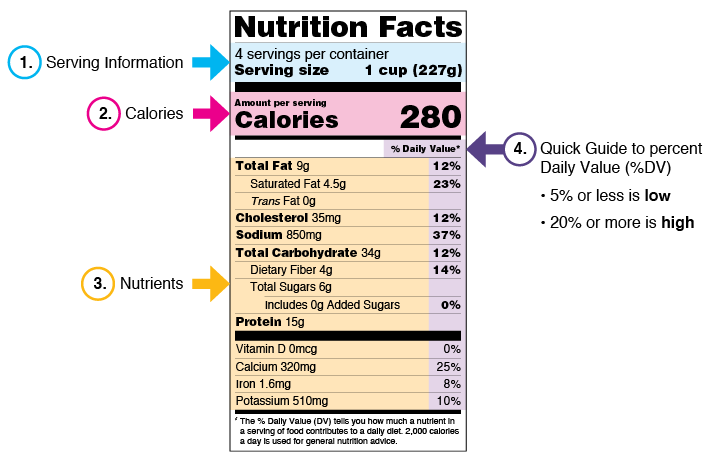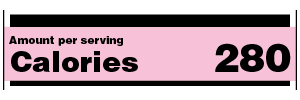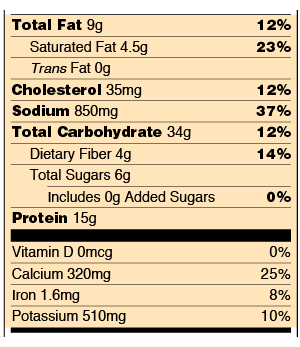”Michigan, do you feel confident reading nutrition labels? Nutrition labels are confusing, and this week's article is all about clearing up the confusion. We hope you find this helpful!
Reading time: 6 Minutes
MWi Hack:
- The following label-reading skills are intended to make it easier for you to use the Nutrition Facts labels to make quick, informed food decisions to help you choose a healthy diet.
MWi Summary:
- Serving Size is standardized to make it easier to compare similar foods
- Calories provide a measure of how much energy you get from a serving of this food
- You can use the label to support your personal dietary needs – look for foods that contain more of the nutrients you want to get more of and less of the nutrients you may want to limit
- The % Daily Value (%DV) is the percentage of the Daily Value for each nutrient in a serving of the food.
Overview
The information in the main or top section (see #1-4) of the sample nutrition label (below) can vary with each food and beverage product; it contains product-specific information (serving size, calories, and nutrient information). The bottom section contains a footnote that explains the % Daily Value and gives the number of calories used for general nutrition advice.
In the following Nutrition Facts label, we have colored certain sections to help you focus on those areas that will be explained in detail. Note that these colored sections are not on the actual food labels of products you purchase.
Sample Label for Frozen Lasagna
1. Serving Information
(#1 on sample label)
When looking at the Nutrition Facts label, first take a look at the number of servings in the package (servings per container) and the serving size. Serving sizes are standardized to make it easier to compare similar foods; they are provided in familiar units, such as cups or pieces, followed by the metric amount, e.g., the number of grams (g). The serving size reflects the amount that people typically eat or drink. It is not a recommendation of how much you should eat or drink.
It’s important to realize that all the nutrient amounts are shown on the label, including the number of calories, refer to the size of the serving. Pay attention to the serving size, especially how many servings there are in the food package. For example, you might ask yourself if you are consuming ½ serving, 1 serving, or more. In the sample label, one serving of lasagna equals 1 cup. If you ate two cups, you would be consuming two servings. That is two times the calories and nutrients shown in the sample label, so you would need to double the nutrient and calorie amounts, as well as the %DVs, to see what you are getting in two servings.
| Example | ||||
|---|---|---|---|---|
| One Serving of Lasagna | %DV | Two Serving of Lasagna | %DV | |
| Serving Size | 1 cup | 2 cups | ||
| Calories | 280 | 560 | ||
| Total Fat | 9g | 12% | 18g | 24% |
| Saturated Fat | 4.5g | 23% | 9g | 46% |
| Trans Fat | 0g | 0g | ||
| Cholesterol | 35mg | 12% | 70mg | 24% |
| Sodium | 850mg | 37% | 1700mg | 74% |
| Total Carbohydrate | 34g | 12% | 68g | 24% |
| Dietary Fiber | 4g | 14% | 8g | 29% |
| Total Sugars | 6g | 12g | ||
| Added Sugars | 0g | 0% | 0g | 0% |
| Protein | 15g | 30g | ||
| Vitamin D | 0mcg | 0% | 0mcg | 0% |
| Calcium | 320mg | 25% | 640mg | 50% |
| Iron | 1.6mg | 8% | 3.2mg | 20% |
| Potassium | 510mg | 10% | 1020mg | 20% |
2. Calories
(#2 on sample label)
Calories provide a measure of how much energy you get from a serving of this food. In the example, there are 280 calories in one serving of lasagna. What if you ate the entire package? Then, you would consume 4 servings or 1,120 calories.
To achieve or maintain healthy body weight, balance the number of calories you eat and drink with the number of calories your body uses. 2,000 calories a day is used as a general guide for nutrition advice. Your calorie needs may be higher or lower and vary depending on your age, sex, height, weight, and physical activity level. Learn your estimated calorie needs at https://www.choosemyplate.gov/resources/MyPlatePlan.
Remember: The number of servings you consume determines the number of calories you actually eat. Eating too many calories per day is linked to overweight and obesity.
3. Nutrients
(#3 on sample label)
Look at section 3 in the sample label. It shows you some key nutrients that impact your health. You can use the label to support your personal dietary needs – look for foods that contain more of the nutrients you want to get more of and less of the nutrients you may want to limit.
- Nutrients to get less Saturated Fat, Sodium, and Added Sugars.
Saturated fat, sodium, and added sugars are nutrients listed on the label that may be associated with adverse health effects – and Americans generally consume too much of them, according to the recommended limits for these nutrients. They are identified as nutrients to get less of. Eating too much-saturated fat and sodium, for example, is associated with an increased risk of developing some health conditions, like cardiovascular disease and high blood pressure. Consuming too many added sugars can make it hard to meet important nutrient needs while staying within calorie limits.
What are Added Sugars and How are they Different from Total Sugars?
Total Sugars on the Nutrition Facts label include sugars naturally present in many nutritious foods and beverages, such as sugar in milk and fruit as well as any added sugars that may be present in the product. No Daily Reference Value has been established for total sugars because no recommendation has been made for the total amount to eat in a day.
Added Sugars on the Nutrition Facts label include sugars that are added during the processing of foods (such as sucrose or dextrose), foods packaged as sweeteners (such as table sugar), sugars from syrups, and honey, and sugars from concentrated fruit or vegetable juices. Diets high in calories from added sugars can make it difficult to meet daily recommended levels of important nutrients while staying within calorie limits.
Note: Having the word “includes” before Added Sugars on the label indicates that Added Sugars are included in the number of grams of Total Sugars in the product.
For example, a container of yogurt with added sweeteners might list:
This means that the product has 7 grams of Added Sugars and 8 grams of naturally occurring sugars – for a total of 15 grams of sugar.
- Nutrients to get more of Dietary Fiber, Vitamin D, Calcium, Iron, and Potassium.
Dietary fiber, vitamin D, calcium, iron ad potassium are nutrients on the label that Americans generally do not get the recommended amount of. They are identified as nutrients to get more of. Eating a diet high in dietary fiber can increase the frequency of bowel movements, lower blood glucose and cholesterol levels, and reduce calorie intake. Diets higher in vitamin D, calcium, iron, and potassium can reduce the risk of developing osteoporosis, anemia, and high blood pressure.
Remember: You can use the label to support your personal dietary needs—choose foods that contain more of the nutrients you want to get more of and less of the nutrients you may want to limit.
4. The Percent Daily Value (%DV)
(#4 on sample label)
The % Daily Value (%DV) is the percentage of the Daily Value for each nutrient in a serving of the food. The Daily Values are reference amounts (expressed in grams, milligrams, or micrograms) of nutrients to consume or not to exceed each day.
The %DV shows how much a nutrient in a serving of food contributes to a total daily diet.
The %DV helps you determine if a serving of food is high or low in a nutrient.
Do you need to know how to calculate percentages to use the %DV? No, because the label (the %DV) does the math for you! It helps you interpret the nutrient numbers (grams, milligrams, or micrograms) by putting them all on the same scale for the day (0-100%DV). The %DV column doesn’t add up vertically to 100%. Instead, the %DV is the percentage of the Daily Value for each nutrient in a serving of the food. It can tell you if a serving of food is high or low in a nutrient and whether a serving of the food contributes a lot, or a little, to your daily diet for each nutrient.
Note: some nutrients on the Nutrition Facts label, like total sugars and trans fat, do not have a %DV – they will be discussed later.
General Guide to %DV
- 5% DV or less of a nutrient per serving is considered low
- 20% DV or more of a nutrient per serving is considered high
More often, choose foods that are:
- Higher in %DV for Dietary Fiber, Vitamin D, Calcium, Iron, and Potassium
- Lower in %DV for Saturated Fat, Sodium, and Added Sugars
Example: Look at the amount of sodium in one serving listed on the sample nutrition label. Is %DV of 37% contributing a lot or a little to your diet? Check the General Guide to %DV. This product contains 37% DV for sodium, which shows that this is a HIGH sodium product (it has more than 20% DV for sodium). If you consumed 2 servings, that would provide 74% of the DV for sodium – nearly three-quarters of an entire day’s worth of sodium.
Compare Foods: Use %DV to compare food products (remember to make sure the serving size is the same) and more often choose products that are higher in nutrients you want to get more of and lower in nutrients you want to get less of.
Understand Nutrient Content Claims: Use %DV to help distinguish one claim from another, such as “light,” “low,” and “reduced.” Simply compare %DVs in each food product to see which one is higher or lower in a particular nutrient. There is no need to memorize definitions.
Dietary Trade-Offs: You can use the %DV to help you make dietary trade-offs with other foods throughout the day. You don’t have to give up a favorite food to eat a healthy diet. When a food you like is high in saturated fat, balance it with foods that are low in saturated fat at other times of the day. Also, pay attention to how much you eat during the entire day, so that the total amount of saturated fat, as well as other nutrients you want to limit, stays below 100%DV.
How the Daily Values Relate to the %DVs
Look at the example below for another way to see how the Daily Values (DVs) relate to the %DVs and dietary guidance. For each nutrient listed in the table, there is a DV, a %DV, and dietary advice or a goal. If you follow this dietary advice, you will stay within public health experts’ recommended upper or lower limits for the nutrients listed, based on a 2,000-calorie daily diet.
Examples of DVs versus %DVs
Based on a 2,000 Calorie Diet
| Nutrient | DV | %DV | Goal |
|---|---|---|---|
| Saturated Fat | 20g | =100% DV | Less than |
| Sodium | 2,300mg | =100% DV | Less than |
| Dietary Fiber | 28g | =100% DV | At least |
| Added Sugars | 50g | =100% DV | Less than |
| Vitamin D | 20mcg | =100% DV | At least |
| Calcium | 1,300mg | =100% DV | At least |
| Iron | 18mg | =100% DV | At least |
| Potassium | 4,700mg | =100% DV | At least |
Upper Limit – Eat “Less than”…
The upper limit means it is recommended that you stay below or eat “less than” the Daily Value nutrient amounts listed per day. For example, the DV for saturated fat is 20g. This amount is 100% DV for this nutrient. What is the goal or dietary advice? To eat “less than” 20 g or 100%DV each day.
Lower Limit – Eat “At least”…
The DV for dietary fiber is 28g, which is 100% DV. This means it is recommended that you eat “at least” this amount of dietary fiber on most days.
Nutrients Without a %DV: Trans Fats, Protein, and Total Sugars:
Note that Trans fat and Total Sugars do not list a %DV on the Nutrition Facts label. Protein only lists a %DV in specific situations listed below.
Trans Fat: Experts could not provide a reference value for trans fat nor any other information that FDA believes is sufficient to establish a Daily Value.
According to the Dietary Guidelines for Americans, there is evidence that diets higher in trans fat are associated with increased blood levels of low-density lipoprotein (LDL or “bad”) cholesterol—which, in turn, are associated with an increased risk of developing cardiovascular disease. Note: most uses of artificial trans fat in the U.S. food supply have been phased out as of 2018.
Protein: A %DV is required to be listed if a claim is made for protein, such as “high in protein.” The %DV for protein must also be listed on the label if the product is intended for infants and children under 4 years of age. However, if the product is intended for the general population 4 years of age and older and a claim is not made about protein on the label, the %DV for protein is not required.
Current scientific evidence indicates that protein intake is not a public health concern for adults and children over 4 years of age in the United States.
Total Sugars: No Daily Reference Value has been established for Total Sugars because no recommendations have been made for the total amount to eat in a day. Keep in mind that the Total Sugars listed on the Nutrition Facts label include naturally occurring sugars (like those in fruit and milk) as well as Added Sugars.
Nutrition Facts Label Variations
Many Nutrition Facts labels on the market will be formatted in the same way as the lasagna label that has been used as an example throughout this page, but there are other formats of the label that food manufacturers are permitted to use. This final section will present two alternate formats: the dual-column label and the single-ingredient sugar label.
MWi would like to thank the FDA for sharing these important insights with our community. Follow this link to find out more:












